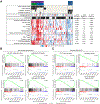Molecular characterisation of hepatocellular carcinoma in patients with non-alcoholic steatohepatitis
- PMID: 33992698
- PMCID: PMC12164395
- DOI: 10.1016/j.jhep.2021.04.049
Molecular characterisation of hepatocellular carcinoma in patients with non-alcoholic steatohepatitis
Erratum in
-
Corrigendum to 'Molecular characterisation of hepatocellular carcinoma in patients with non-alcoholic steatohepatitis' [J Hepatol 75 (2021) 865-878].J Hepatol. 2021 Dec;75(6):1515. doi: 10.1016/j.jhep.2021.09.014. Epub 2021 Oct 7. J Hepatol. 2021. PMID: 34627652 No abstract available.
Abstract
Background and aims: Non-alcoholic steatohepatitis (NASH)-related hepatocellular carcinoma (HCC) is increasing globally, but its molecular features are not well defined. We aimed to identify unique molecular traits characterising NASH-HCC compared to other HCC aetiologies.
Methods: We collected 80 NASH-HCC and 125 NASH samples from 5 institutions. Expression array (n = 53 NASH-HCC; n = 74 NASH) and whole exome sequencing (n = 52 NASH-HCC) data were compared to HCCs of other aetiologies (n = 184). Three NASH-HCC mouse models were analysed by RNA-seq/expression-array (n = 20). Activin A receptor type 2A (ACVR2A) was silenced in HCC cells and proliferation assessed by colorimetric and colony formation assays.
Results: Mutational profiling of NASH-HCC tumours revealed TERT promoter (56%), CTNNB1 (28%), TP53 (18%) and ACVR2A (10%) as the most frequently mutated genes. ACVR2A mutation rates were higher in NASH-HCC than in other HCC aetiologies (10% vs. 3%, p <0.05). In vitro, ACVR2A silencing prompted a significant increase in cell proliferation in HCC cells. We identified a novel mutational signature (MutSig-NASH-HCC) significantly associated with NASH-HCC (16% vs. 2% in viral/alcohol-HCC, p = 0.03). Tumour mutational burden was higher in non-cirrhotic than in cirrhotic NASH-HCCs (1.45 vs. 0.94 mutations/megabase; p <0.0017). Compared to other aetiologies of HCC, NASH-HCCs were enriched in bile and fatty acid signalling, oxidative stress and inflammation, and presented a higher fraction of Wnt/TGF-β proliferation subclass tumours (42% vs. 26%, p = 0.01) and a lower prevalence of the CTNNB1 subclass. Compared to other aetiologies, NASH-HCC showed a significantly higher prevalence of an immunosuppressive cancer field. In 3 murine models of NASH-HCC, key features of human NASH-HCC were preserved.
Conclusions: NASH-HCCs display unique molecular features including higher rates of ACVR2A mutations and the presence of a newly identified mutational signature.
Lay summary: The prevalence of hepatocellular carcinoma (HCC) associated with non-alcoholic steatohepatitis (NASH) is increasing globally, but its molecular traits are not well characterised. In this study, we uncovered higher rates of ACVR2A mutations (10%) - a potential tumour suppressor - and the presence of a novel mutational signature that characterises NASH-related HCC.
Keywords: animal model; liver cancer; metabolic syndrome; molecular class; mutational signature; obesity.
Copyright © 2021 European Association for the Study of the Liver. Published by Elsevier B.V. All rights reserved.
Conflict of interest statement
Conflict of interest J.M.L. receives research support from Bayer HealthCare Pharmaceuticals, Eisai Inc, Bristol-Myers Squibb, Boehringer-Ingelheim and Ipsen, and consulting fees from Eli Lilly, Bayer HealthCare Pharmaceuticals, Bristol-Myers Squibb, Eisai Inc, Celsion Corporation, Exelixis, Merck, Ipsen, Genentech, Roche, Glycotest, Leerink Swann LLC, Fortress Biotech, Nucleix, Can-Fite Biopharma, Sirtex, Mina Alpha Ltd and AstraZeneca. S.L.F consults for the following companies: 89 Bio, Amgen, Axcella Health, Blade Therapeutics, Bristol Myers Squibb, Can-Fite Biopharma, ChemomAb, Escient Pharmaceuticals, Forbion, Foresite laboratories, Galmed, Gordian Biotechnology, Glycotest, Glympse Bio, Hepgene, In sitro, Morphic Therapeutics, North Sea Therapeutics, Novartis, Ono Pharmaceuticals, Pfizer Pharmaceuticals, Scholar Rock Surrozen. He has stock options in the following companies: Blade Therapeutics, Escient, Galectin, Galmed, Genfit, Glympse, Hepgene, Lifemax, Metacrine, Morphic Therapeutics, Nimbus, North Sea Therapeutics, Scholar Rock, Surrozen. He receives research support from Morphic Therapeutics, Novo Nordisk, and Galmed, and has an SBIR grant with Abalone Bio. A.L. is a consultant for Neuwave and Histosonics. C.P.M.S.O. consults for Bayer, Novartis, Novonordisk, Allergan, Pfizer, Roche and Zambon. P.S. is receiving research grants from BMS, Roche, Incyte, Chugai and consulting fees from BMS, MSD, Incyte, Janssen, Roche, AstraZeneca and Amgen. H.W., P.T., and A.V.U. are or were salaried employees of Sema4 at the time of the study. H.W., P.T., and A.V.U. hold Sema4 stock options. B.M. received consultancy fees from Bayer-Shering Pharma, and speaker fees from Eisai and MSD. The rest of authors have nothing to disclose. Please refer to the accompanying ICMJE disclosure forms for further details.
Figures






Comment in
-
Molecular landscape of NASH-HCC.Nat Rev Gastroenterol Hepatol. 2021 Jul;18(7):456. doi: 10.1038/s41575-021-00478-6. Nat Rev Gastroenterol Hepatol. 2021. PMID: 34103708 No abstract available.
References
-
- Llovet JM, Kelley RK, Villanueva A, Singal AG, Pikarsky E, Roayaie S, et al. Hepatocellular carcinoma. Nat Rev Dis Prim 2021;7:6. - PubMed
-
- Younossi ZM, Koenig AB, Abdelatif D, Fazel Y, Henry L, Wymer M. Global epidemiology of nonalcoholic fatty liver disease—meta-analytic assessment of prevalence, incidence, and outcomes. Hepatology 2016;64:73–84. - PubMed
-
- Anstee QM, Reeves HL, Kotsiliti E, Govaere O, Heikenwalder M. From NASH to HCC: current concepts and future challenges. Nat Rev Gastroenterol Hepatol 2019;16:411–428. - PubMed
-
- Villanueva A Hepatocellular carcinoma. N Engl J Med 2019;380:1450–1462. - PubMed
Publication types
MeSH terms
Grants and funding
LinkOut - more resources
Full Text Sources
Other Literature Sources
Medical
Molecular Biology Databases
Research Materials
Miscellaneous

